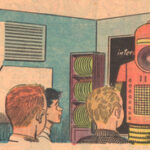Colored Objects
Subject: Physics
Grade Level(s): High School
Topic: Color
Big Idea(s):
- To observe different colored objects in different colors of light to determine what colors are reflected and absorbed by each color.
- To learn how color printing is done.
What you need:
- Light Box
- Power Supply
- Color Filters (Red, Green, Blue, Yellow, Cyan, Magenta)
- Color Cards (Red, Green, Blue, Yellow, Cyan, Magenta
- Color Newspaper Pictures
- Magnifying Glass
Summary:
In this activity, your students will investigate the effect of shining different colored lights on different colored objects.
When light hits an object, the object may reflect, absorb, or transmit the light. Depending on the properties of the object, it may reflect, absorb, and transmit different parts of the spectrum. The spectrum can, as students know from the earlier activities, be represented by only three colors: red, blue, and green. A red apple appears to be red because it reflects red light and absorbs everything else. A yellow banana appears to be yellow because it reflects red and green light (which add to give yellow) and absorbs blue light. White paper reflects all three primary colors and absorbs nothing. Black paper absorbs all three primary colors and reflects nothing.
Students will also investigate color newspaper pictures. Newspaper printing is done with a three-color process. The primary subtractive colors (yellow, cyan, and magenta) are used, along with black, to produce the full spectrum of color seen in the paper. Very small dots of ink are printed in the four different colors. If dots are placed close together, your eye sees the colors as being combined as in the Color Subtraction activity.
To produce a green color, for instance, yellow and cyan dots are used. The yellow ink subtracts blue from what you see, and cyan subtracts red. What is left is green, and that is the color you observe.
Learning Goals / Objectives:
- To learn how colored objects appear in different colors of light.
- To learn how color printing is done.
Background
A darkened room will make observations easier. You may want to label the colored cards, so that they can be identified in dim light.
Use the end of the light box without the mirrored doors.
Students will need magnifiers to look at newspaper. Small hand-held magnifiers will do, or microscopes may be used for higher magnification. The comics section from the Sunday paper is a good source for color pictures.
Anticipatory Set:
• How do different colored objects appear in different colors of light?
• How are color newspaper prints made?
Instructions / Activities:
Plug the light box into the power supply. For this experiment, you will use the end of the light box without the swinging doors.
Part I: Reflection of Red, Blue, and Green
- Place the Red color filter in the slot.
- Hold the Red colored card in the Red light. It should appear bright because red objects reflect red light. Record this in the table below by writing “Yes” in the square for the Red light and a Red object.
- Hold the Blue colored card in the Red light. It should appear dark because blue objects absorb red Light and do not reflect it. Record this in the table below by writing “No” in the square for Red light and a Blue object.
- Repeat this for all the color combinations in the table below.

Part II: Reflection of Yellow, Magenta, and Cyan
- Place the Yellow color filter in the slot.
- Hold the Red colored card in the Yellow light. What color do you see? Record the color you see in the table below.
- Repeat this for all the color combinations in the table below. If the card appears to be dark, write “Black” in the table.

Part III: Color Printing
- Use a magnifying glass to look at a color picture in a newspaper. Draw what you see under the magnifying glass.
- Find an area in the picture that is green. Look with the magnifying glass and describe the colors of the dots you see.
- Find an area in the picture that is red. Look with the magnifying glass and describe the colors of the dots you see.
- Find an area in the picture that is red. Look with the magnifying glass and describe the colors of the dots you see.
- How many different colors of dots are used to print the whole newspaper? List the ink colors you see under the magnifying glass.
Assessment:
Teacher’s Discretion
Wrap-up / Closure:
- For each of the following, explain the observed color. In your explanation, describe which primary additive colors are included in the light, and which colors the object reflects.
- A red apple appears to be red under white light.
- A red apple appears to be black under blue light.
- A yellow banana appears to be yellow under white light.
- A yellow banana appears to be red under magenta light.
- A yellow banana appears to be green under cyan light.
- A blue police car looks black under a yellow streetlight.
These materials are contained in a kit in our Library!
Tags: High School
Categories: Physics


